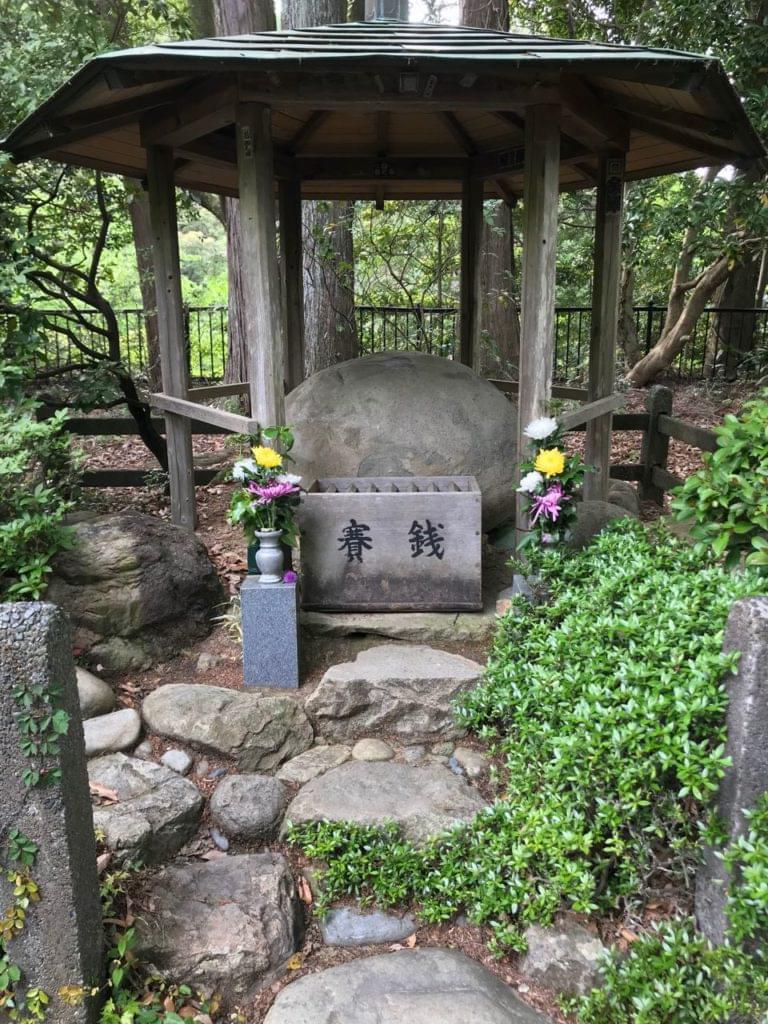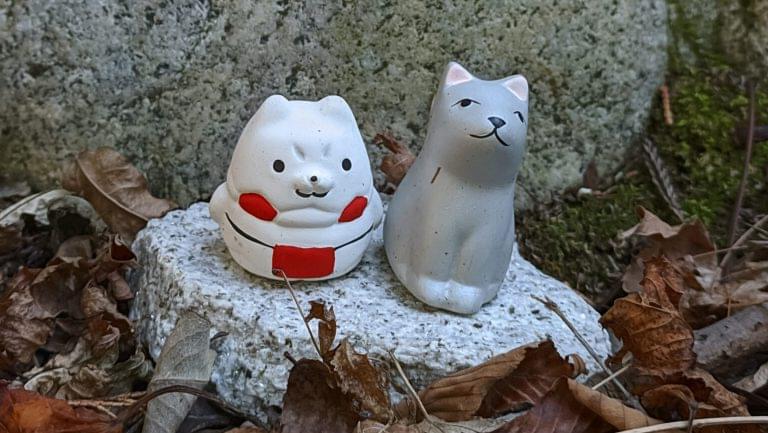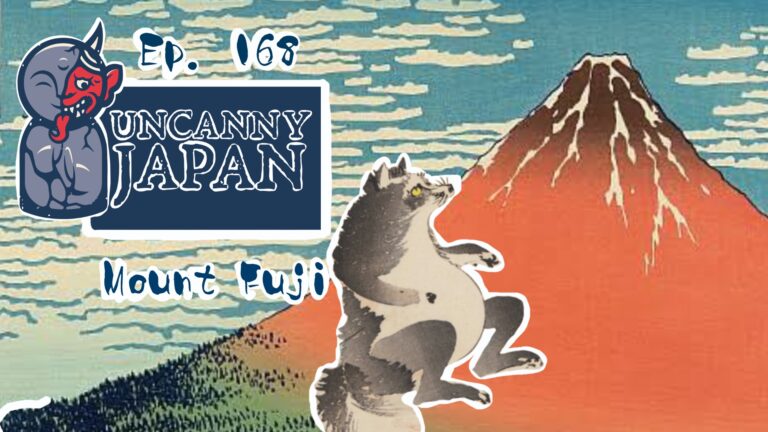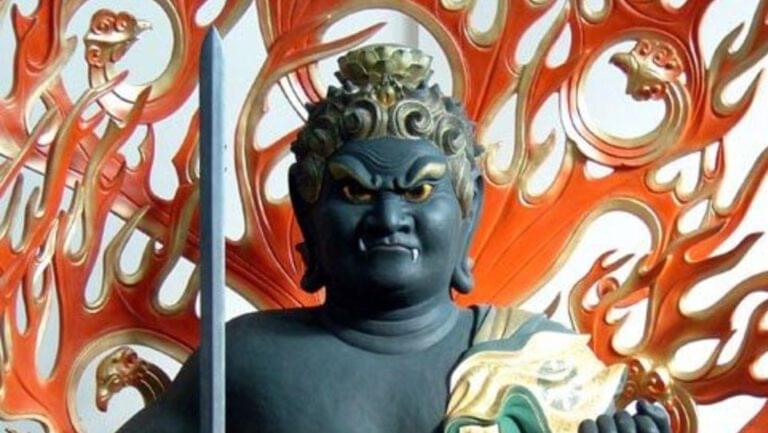A rock that gets weepy when the sun goes down, a pregnant woman slain alone in the mountains, a newborn baby visited by a ghostly priest who feds him candy to stay alive. These are all parts of this month’s podcast: The Rock That Cries at Night (Yonaki Ishi). In this episode, I visit a local spot (one of the Enshu Nanafushigi / Seven Mysterious Things of Enshu).
Come listen to me tell the tale about the rock that cries at night while I sit by some rain, thunder, and an ambitious frog.
It’s a wonderful old legend, but can you find the big question (plot hole?) that I discovered when I researched and retold the story?

One of the two Yonaki Ishi
Uncanny Japan is author me, Thersa Matsuura, exploring all that is weird from Japan. Strange superstitions and old wives tales, cultural oddities and interesting language quirks. These are little treasures I dig up while doing research for my writing. And I want to share them with you here on Uncanny Japan. I hope you like the show.
Hey, hey everyone. It’s been a while, sorry about that. But I’ve been busy, good busy. I was approached by a Japanese newspaper, the Asahi Weekly, to write a 12 part serialized story to be published from July through September. At first I thought I could send the story in a little bit at a time, but it turns out they wanted the whole thing at once. So I’ve been spending all my extra time working on that. I did get it turned in and the editor says he really likes it, so yay.
And I’m actually quite fond of the story myself. As a matter of fact, I’m going to record it as a Patreon reward in three parts. I just sent the first part, the first four chapters or four weeks worth to my Patreons the other day.
The Story of The Rock That Cries At Night
Let’s get on to today’s topic. If you remember in the last episode, I mentioned doing local legends or weird tales every so often. So that’s exactly what I’m going to do now. The first one is also one of the Nanafushigi, or seven mysterious things of this area. They’re called Enshu no Nanafushigi.
So this is how I first learned about the legend of the rock that cries at night.
Kosodate Ame
It was nearly 20 years ago when my mother in law brought over a box wrapped in rough paper and tied with twine. She said it was an omiyage or a souvenir from a local spot. After she left, I opened it to find a plastic container filled with this viscous amber colored goo. Being the type of person who assumes most gifts in Japan are edible, I formed a large sticky globule by twirling a chopstick in the stuff and carefully placed it in my mouth. It tasted sweet, but not too sweet, if that makes sense.
When I checked the ingredients listed on the back of the box, the only two listed were glutinous rice and malt. Later, I learned this treat was called Kosodate Ame, or child rearing candy. That’s the literal translation, but I just learned it also goes by the name ghost candy. My mother in law had purchased it a couple towns over in a place called Kakegawa. There sits a small boulder that has the unsettling tendency to weep after the sun goes down. It’s called Yonaki Ishi, or the stone that cries at night. I was intrigued, so I decided to go visit.
There are a few Yonaki Ishis around Japan, but this one near me in Kakegawa is the most well known. Of course, even with this story, there are a couple variations. The following though is the one I first heard. It was told to me by the skittish little old man who worked in the souvenir shop and, because it had gone so quickly, sold me my second box of that delightful taffy like syrup. Here’s the story he told me.
The Story
Once upon a time, cradled in a forest, on top of a tall hill in Kakegawa, stood a temple dedicated to the female Bodhisattva Kannon. It was, and still is, called Kyuenji.
One day at the foot of the hill, a married couple from Kyoto came to live. The wife, who just happened to have the nickname Koishi Hime, little rock princess, was kind and virtuous and very fond of this temple. Daily, she’d trek up the large hill to pay her respects to Kannon. She did this even after she became pregnant, even after her husband got called back to Kyoto on business, even after she was very pregnant.
One night, she made her trip to the temple, but on the way back, grew tired and stopped to rest beside a boulder. Suddenly, a bandit leapt out from behind the trees and drew his long katana sword. He demanded Koishi Hime’s money, but when she told him she was poor and that she had no coin on her, he became enraged and came at her with his sword. They fought. Koishi Hime cried out for someone to help anyone, Kannon. But the temple was quite a ways up the hill and no one lived near where she rested against the boulder.
Koishi Hime put up a good fight, but she was very tired and very pregnant and could not fend off the brute. He threw her against the rock and cut her deeply with his katana. The blade, however, was stopped from injuring the unborn child when the tip hit the stone. The thief fled.
Koishi Hime pleaded for someone to save her child. With what strength she had left, she gave birth to a baby boy. The last words on her lips were a quiet prayer to Kannon.
Later, both the monks and the people down at the foot of the hill heard the sound of an infant crying at night. They could not understand why or where the noises were coming from. Someone said that it was indeed the rock that was crying. Thinking the stone possessed, the frightened townspeople stayed away.
All during this time, also down in the town, there was a man named Bunpei who sold sweets. Every night after dark, a traveling monk would enter his shop just before he was about to close and ask to buy some soft candy. Bunpei had never seen this monk before and when he tried to make conversation, the monk was silent. He just took his purchase, walked out of the street, and disappeared. Finally, Bunpei could take it no more. He waited until the traveling monk came, sold him his candy, and secretly followed him.
The candy seller Bunpei was surprised to find the monk hike up the hill and approach the large stone that was crying like a child. The moon was but a sliver that night so he couldn’t see well, only that the monk leaned down, doing something. Then, as he stood and turned to go, he disappeared like fog scattered by wind.
Bunpei wanted to flee, but his curiosity got the best of him. Plus, the rock had stopped crying. When he got to the rock that everyone was so frightened of, he only found a small baby wrapped in a woman’s torn kimono, sleeping sweetly. He looked around, but no one was there. He examined the rock, and seeing the nick in the stone, along with the torn and dirtied kimono, guessed what might have happened. Bunpei carefully scooped up the child and went straight up the hill to consult with the abbot of Kyuun Temple.
The abbot remembered Koishi Hime and how worried he had been when she stopped visiting the temple daily. He thought that maybe she had the baby and was resting at home. But after hearing Bunpei’s story, the abbot decided it had been, in fact, Kanon herself, who had taken the ghostly form of a traveling monk, visited the sweet shop buying the soft candy made from glutinous rice and malted wheat in order to nourish the infant and keep it alive.
The abbot then asked Bunpei if he felt he could raise the boy, since it was him who Kanon chose to visit and reveal herself to. The candy seller said he was very poor, but that he would definitely try and raise the child as his own.
Bunpei named the boy Otohachi and took great care of him. Otohachi might not have had a lot of material possessions, but he was greatly loved and, for the most part, happy.
When he was of a certain age, he was told the story of his mother and how the bandit had cut her down and how the rock had stopped the blade from killing him. At 15, the boy had a dream in which Kanon told him to become a sword sharpener. Heeding this call, he soon left his life with his father and took up residence in a sword shop in town.
Otohachi studied hard for many years until one day a man he’d never seen before visited and asked him to sharpen a sword he had not used for many years. Otohachi immediately noticed a great chunk taken out of the tip of the katana. This is such a wonderful blade. I wonder what could have happened to cause such damage, Otohichi said. Oh, that. Yes, that happened ages ago, right up there, actually. The stranger pointed to the mountain over Otohachi’s shoulder, the mountain that held the Kanon temple and the stone that persisted in weeping nightly for him.
“Please tell me more,” Otohachi said.
“Well, you can say I got into a scuffle while taking care of business and ended up hitting a rock.”
The stranger was able to laugh almost a full minute before he noticed that Otohachi had stood up with the sword in his hands.
“So it was you. You were the one who cut down my mother.” The stranger’s eyes widened. “I am the child that was saved by that rock and the compassionate Kanon.”
Then, using the same sword that took his mother’s life, Otohachi avenged her death.
The end.
My Trip to Yonaki Ishi
Now, I hadn’t been to Yonake Ishi in over 20 years, so I definitely wanted to visit again before I did this podcast. I am what you call in Japanese a hokou onchi, or someone who is terrible with direction.
I took a friend along with me, and while I thought I knew where I was going, I got lost. My friend whipped out their phone and navigated, but it was wrong. It was close, but it felt like a totally different part of the hill. I objected, my friend continued their navigation, and I continued my objections.
But lo and behold, we made it. It was a different place, though, but the sign said Yonake Ishi, and there was a temple.
I didn’t remember the temple from my previous visits, just the little shop selling candies. At this new place, I found this shop nearby with this tiny old woman selling ghost candy that she would stick a pair of wooden chopsticks in, twirl to get a good glob, and then sell to children who came to visit the temple with their parents. From her, I learned there are actually two rocks that cry at night. This one at the temple that she said had been brought up from its original location, and then another rock, the one that I had visited years and years ago. That was on the other side of the hill.
When I asked her which one was the original, she didn’t really say. So I took photos of both, bought some kosodate ame, or ghost candy, which I also took some pictures of. I even found some kosodate ame hard candy. It’s the same recipe, but individually wrapped. I picked up some of those from my Tengu and Oni patrons so they can taste what this ghost candy tastes like. It’s quite yummy.
So if you’re ever in Kakegawa, you too can visit the two rocks that cry at night, Yonake Ishi.
Thank you for listening. I’m aiming for two episodes next month because I shouldn’t have any deadlines, and I want to give a special thank you and special love to all my patrons and everyone who supports the show. Thank you so much, and I will talk to you soon. Bye bye.
Psst. Hey, do you like scary stories? Or maybe you don’t do full on horror, but enjoy a nice dark tale, something creepy involving Japanese folklore and superstition? Well, if that’s the case, you can sneak on over to Amazon or wherever you like to buy books and look for my two short story collections, A Robe of Feathers and The Carp Faced Boy. All you need to do is search for Thersa Matsuura. Let me spell that for you. T H E R S A, M A T S U U R A. Another place you can find me doing things is on Patreon. There, once a month, for my $5 and up patrons, I translate, retail, and record obscure Japanese folk tales. Some are dark, some are humorous, some are just weird. And lastly, another super sweet thing you can do is to write a review on iTunes. By doing this, you help like minded people find Uncanny Japan. It’s a little thing, but it means a lot, and it’s a great big help. Thank you, I’m Thersa Matsuura, and I’ll talk to you soon.
Credits
Intro and outro music by Julyan Ray Matsuura






